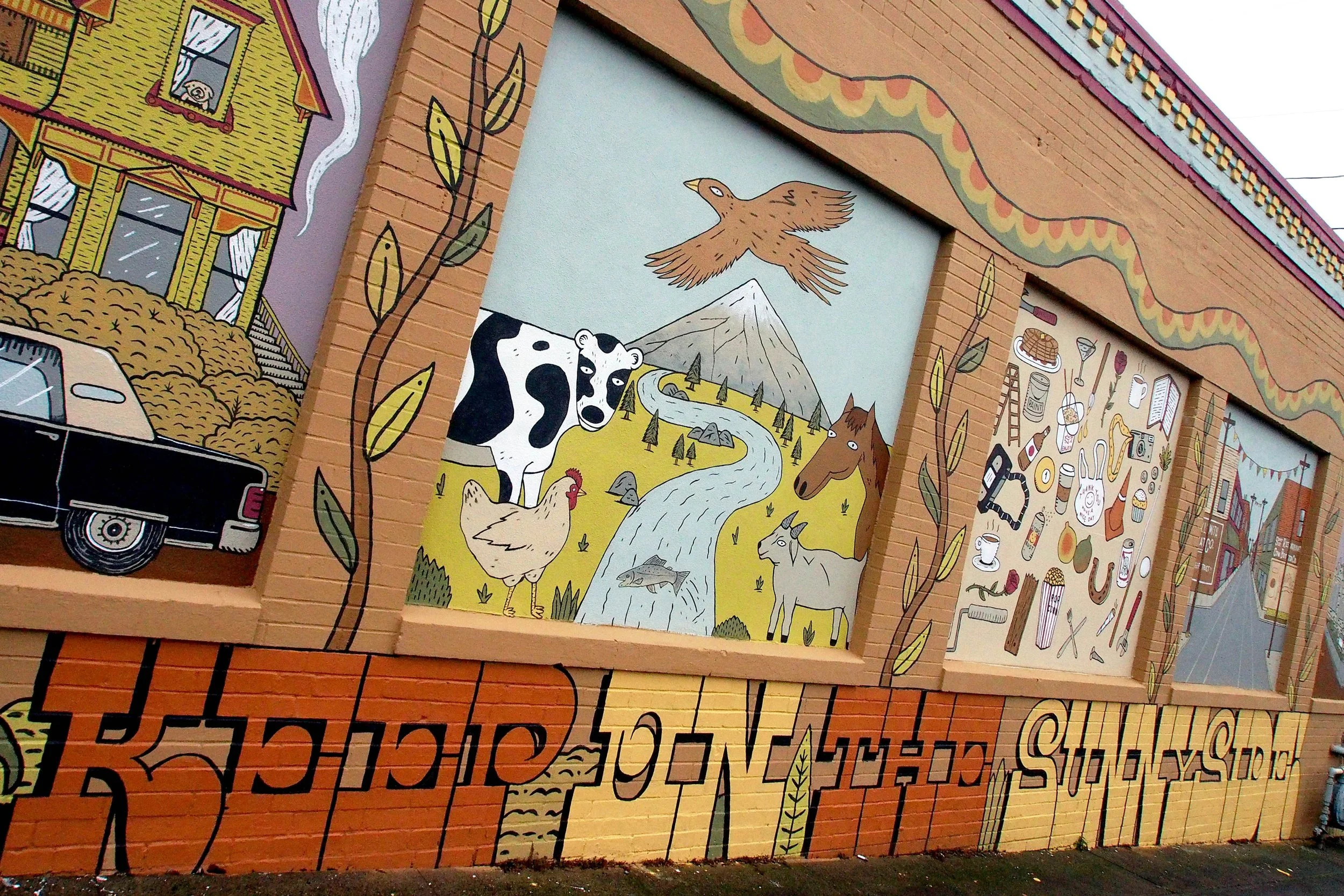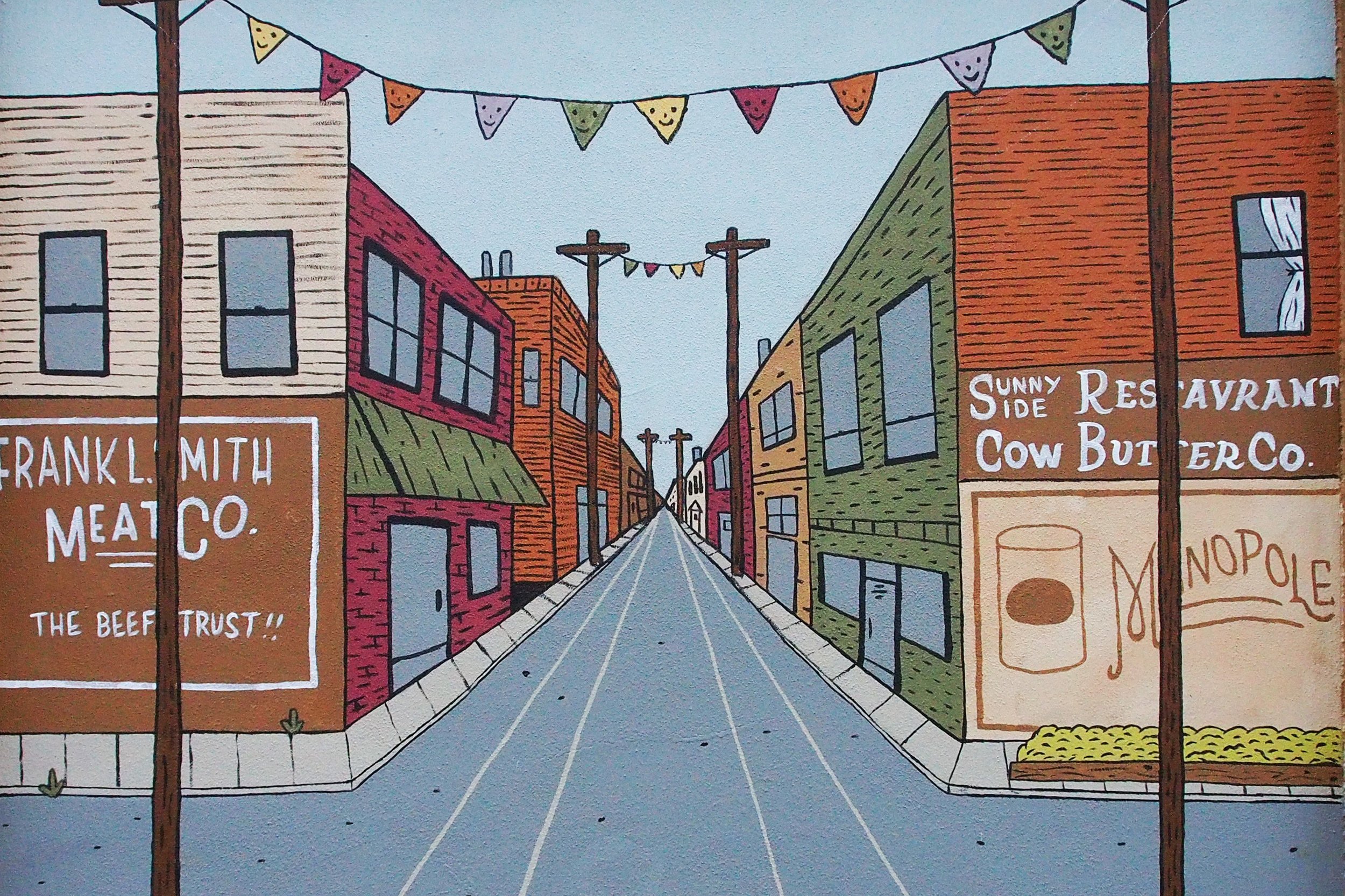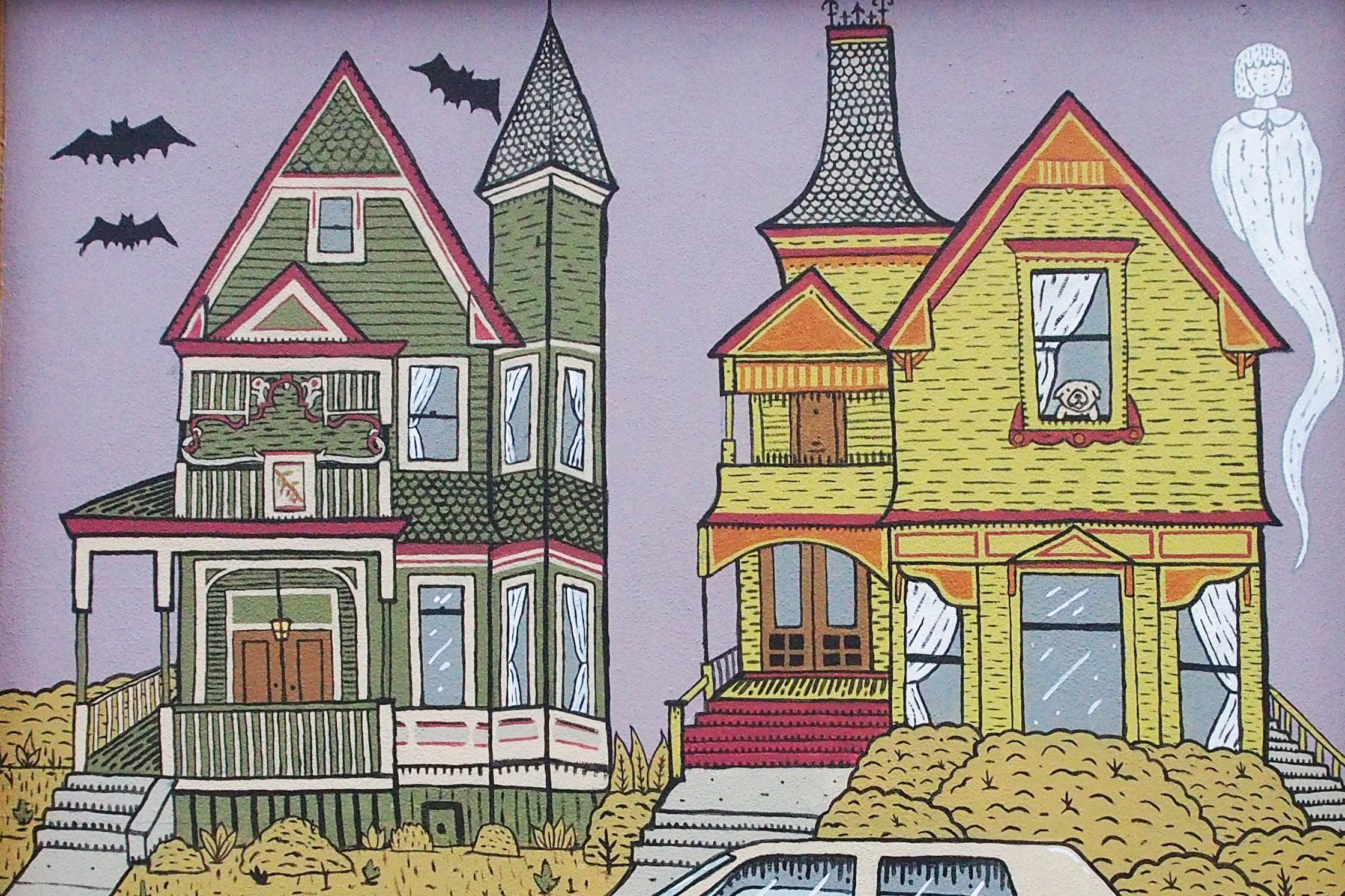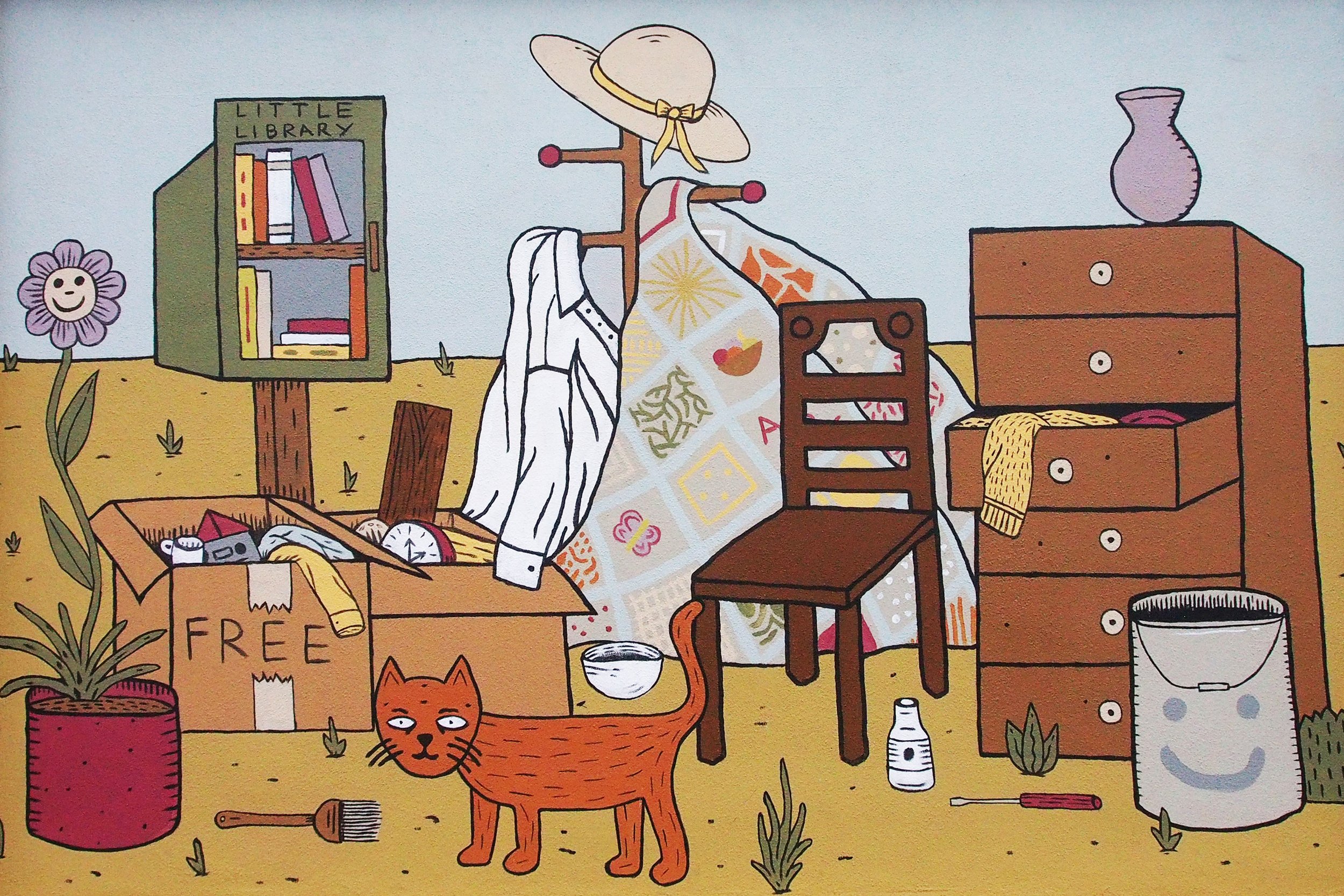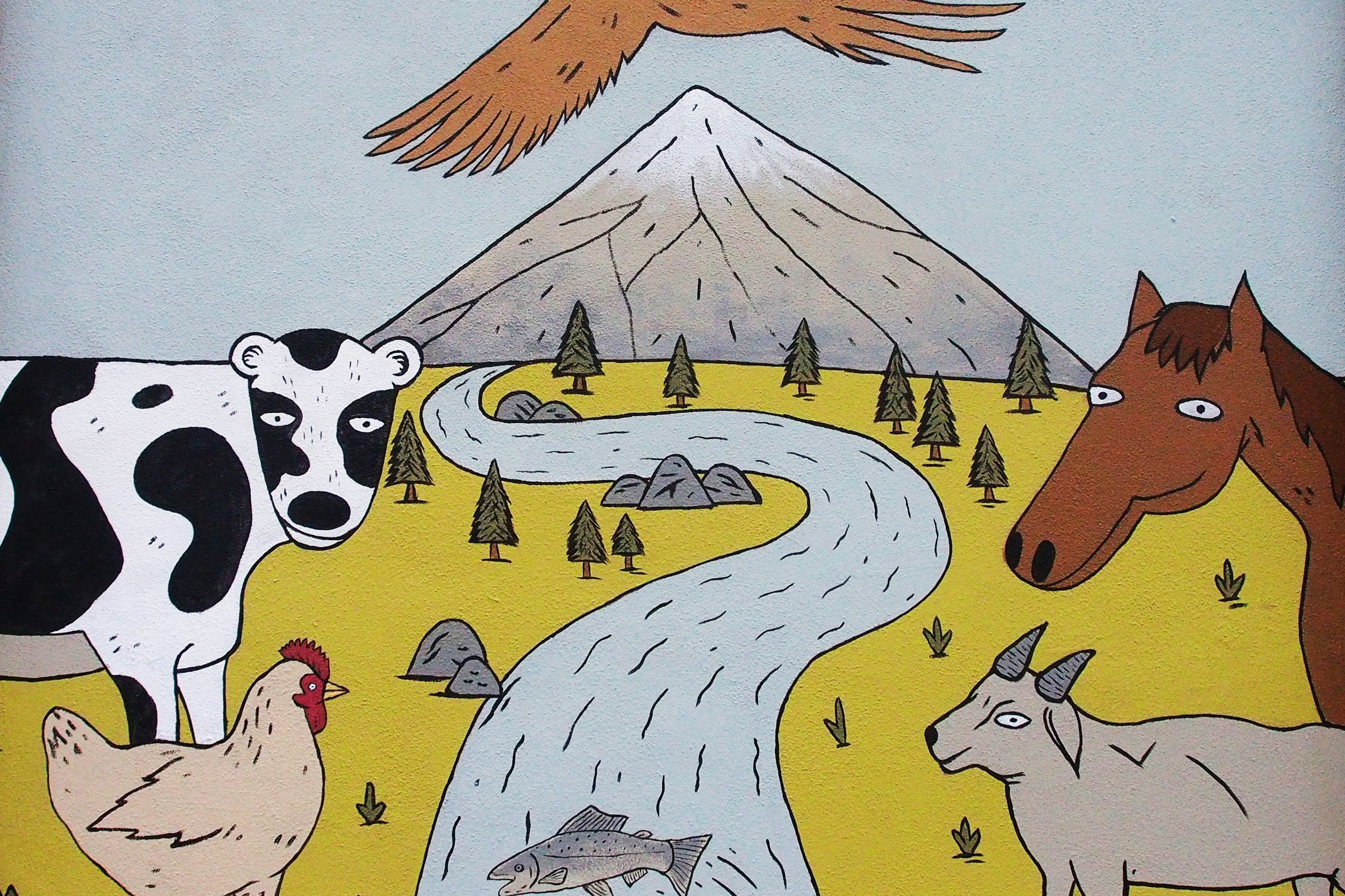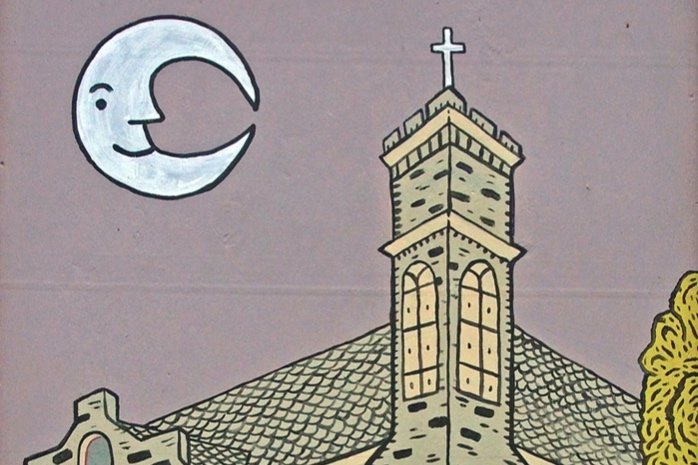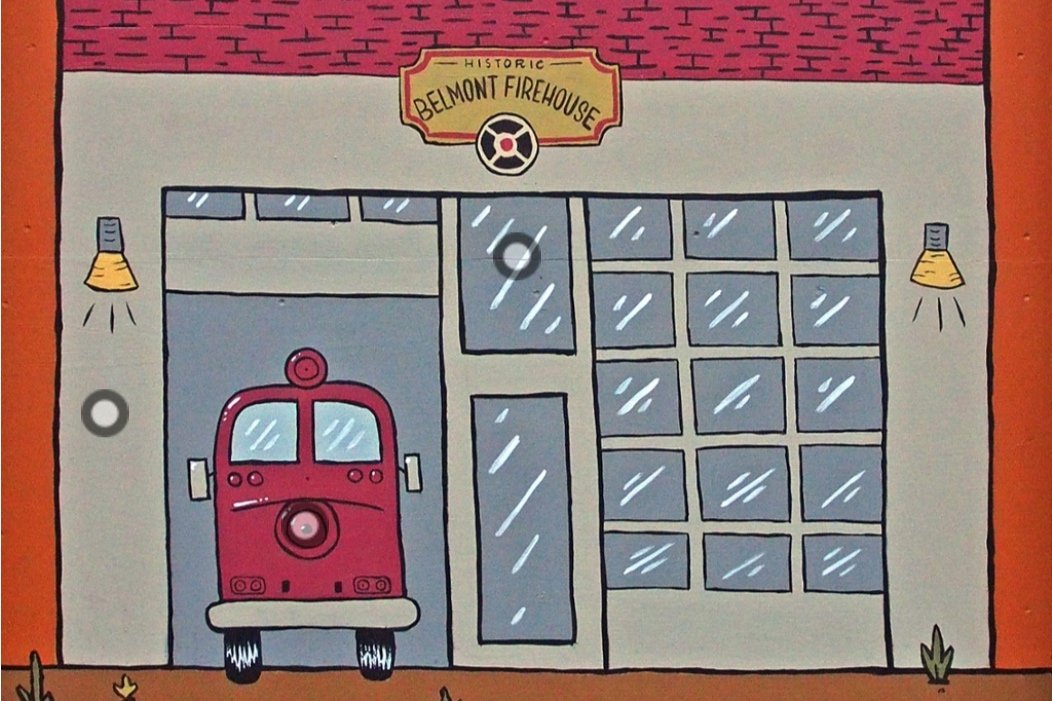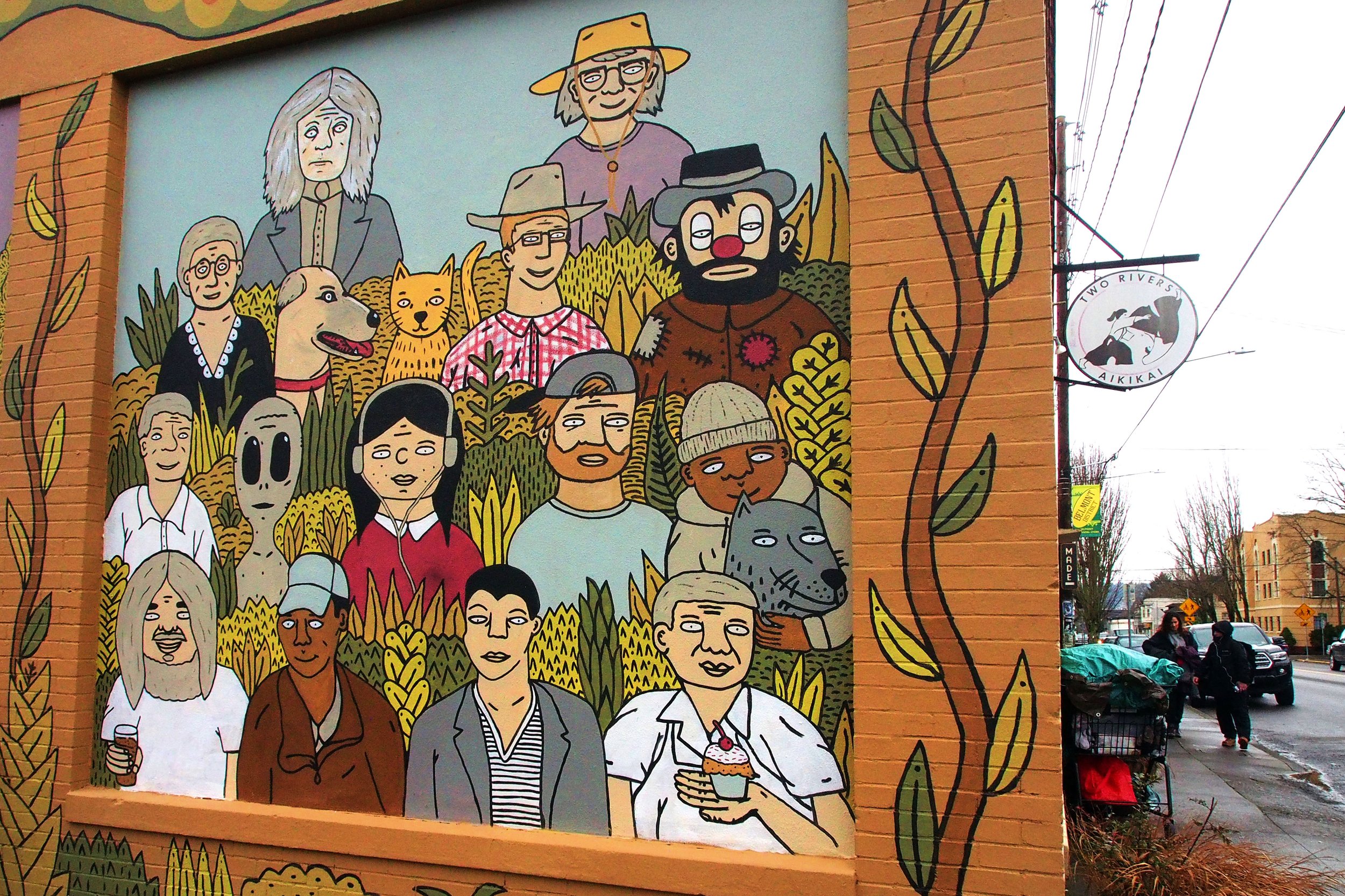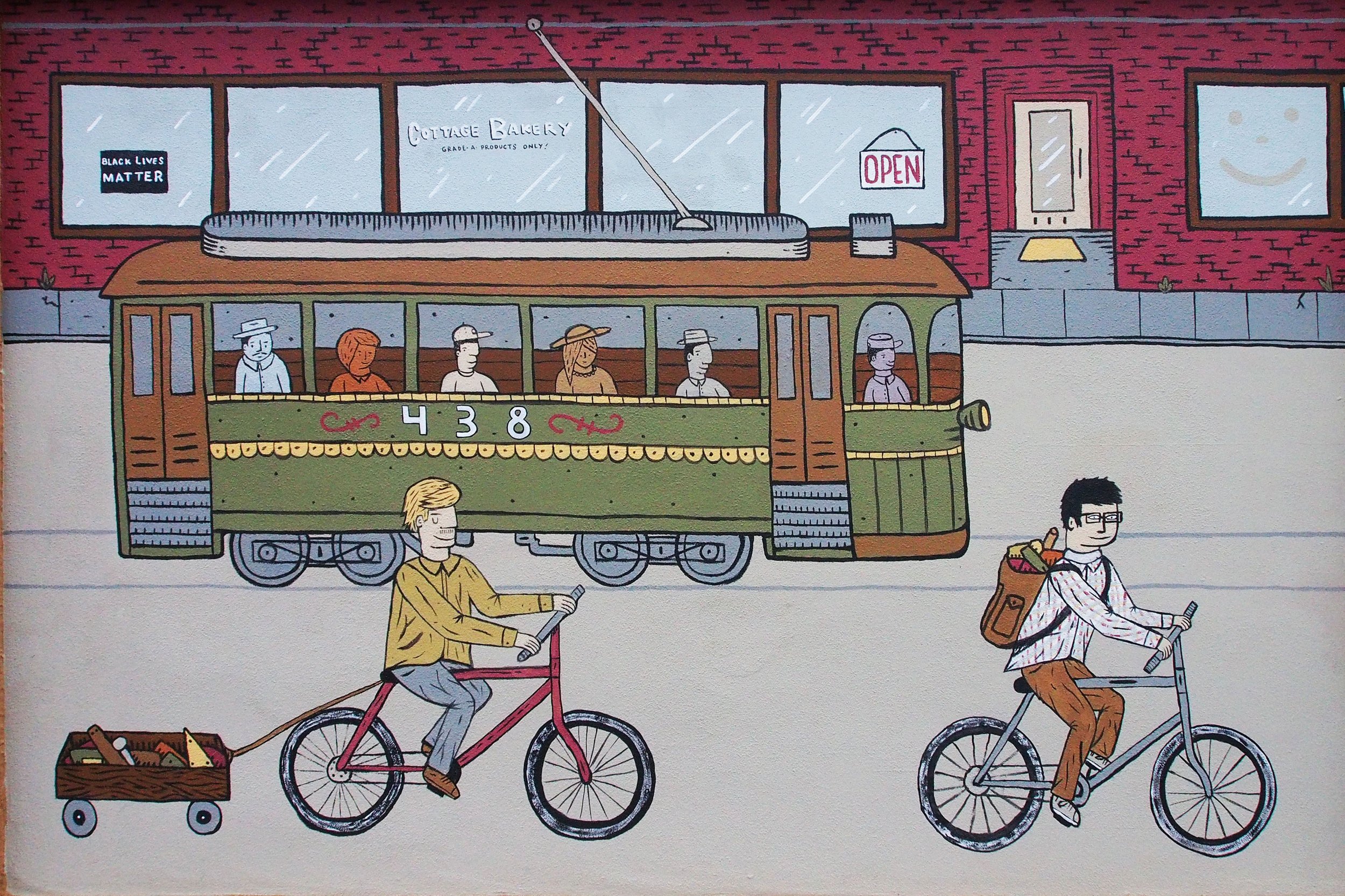KEEP ON THE SUNNYSIDE
PORTLAND, OREGON
KEEP ON THE SUNNYSIDE MURAL
With extensive research and community outreach, PSAA worked with local street artist Maddo Hues (@yomaddo) to design this 100-foot mural that represents significant elements of the Sunnyside neighborhood's past and present. The project was sponsored by @seuplift and community donations. PSAA donated all of our management time, along with countless volunteers from the community who helped us prep the wall, deliver flyers and send emails. We hope that this mural serves as a platform for exploring Sunnyside's rich and vibrant history and a daily reminder that no matter how grey it might be, to always try to keep on the sunny side of life!
THE PLACES + THINGS OF SUNNYSIDE
EARLY SE PORTLAND HISTORY
The Portland metro area rests on traditional village sites of the Multnomah, Kathlamet,Clackamas, Chinook, Tualatin Kalapuya, Molalla and many other Native American tribes.They created communities and summer encampments along the Columbia and Willamette Rivers and harvested and used the plentiful natural resources of the area for thousands of years. The first white settler in the area, in the late 1820s, was a French Canadian fur trapper named Etienne Lucier. At the time Lucier arrived in East Portland, it was "heavily timbered with a thick undergrowth of laurel and fern." He built a cabin just south of where Hawthorne St is now. The cabin was later occupied by an employee of the Hudson's Bay Company, which was held in trust by John McLoughlin. In 1845, McLoughlin sold the land to James & Elizabeth Stephens. Mr. Stephens was a cooper and ferryman by trade. The original cabin is gone, but the Stephen's house still stands at the corner of SE 12th & Stephens St, and is the oldest structure in SE Portland. Despite the marshy conditions down by the Willamette River, Stephens started ferrying pioneers across the river to downtown Portland around 1861.
In early years Sunnyside was full of farms and fur trappers.
During the first three decades (1860s-1880s), East Portland was mainly occupied by fur trapper cabins and small family farms.The area Sunnyside encompasses today was settled on a portion of the Seldon Murrary land claim. A United States Land Patent, signed by President Andrew Jackson on March 19, 1866, was issued to Seldon and Hiantha Murray. They farmed the land for six years, then started to sell it off in portions for $10 an acre. Sunnyside and Lone Fir Cementary are part of the original Murray land claim.
HISTORIC HOUSES
The Thaddeus Fisher House
In 1888, Thaddeus “Thad” F. Fisher and his wife Phoebe escaped the city and built a house just off Belmont at the edge of the city. Thad was a prominent Woodsmen of the World, a man of earnest endeavor who bore the respect of all who knew him (Multnomah County Archives). The house was built in the high style of Queen Anne, popular during the late 1800s. They planted plum and apple trees which still stand to this day. Highly ornamental in design, the house included intricate woodwork, intersecting cross gables, a 3-story tower, and a steeply pitched irregular roof. A large veranda coils around half the main house. Set back and slightly higher than the street, the ‘life’ of the house is thrust upward into the sky, establishing a sense of continuity between the house and the surrounding overgrown setting. On almost a daily basis, people take pause on the sidewalk looking at the house, pointing, talking, and sometimes asking questions. Old neighborhood residents often stop by to reminisce and tell tales of the house’s past.
The Fishers were a well-off couple. Thad was a sea merchant during a time when Portland was becoming a key hub for shipping in the west. This house would have surely been a bold statement, a symbol of their class standing. During this time, the production of new inhabitable space on Portland’s Eastside was just beginning. Flight from the discords wrought by the industrial machine age was an achievement mostly possible for those who were wealthy enough to move. The elite were on a quest to escape the grimy city and reconnect to the natural world, enjoy sunlight, fresh air, greenery, and open space. SE Portland would have been a very different type of place to live in the late 1800s. The majority of the roads were still dirt and gravel, which turned to mud during the rainy months (Portland Paving Map). Horses and kerosene lamps were everyday objects, as electricity and automobiles were bourgeoning ideas. The Fishers, and their neighbors, were urban pioneers settling in and taming this new environment. There would have been an enthusiasm brewing in the Sunnyside neighborhood, because the very same year the Fishers built their home, the Mt. Tabor streetcar line began, extending from the river to 34th and Belmont.
The Fishers did not have any children. Thad passed away in 1904 and was buried down the avenue at Lone Fir Cemetery. His wake was held at his home. A few years after Thad passed away Pheobe remarried a man that was boarding in the house for many years, Edgar Allen. The house remained in the Fisher family until 1935 when Phoebe sold it. Interestingly, Edgar is buried right next to Thaddeus in Lone Fir Cemetery, along with his son, but Phoebe lies in an unmarked grave in-between her two husbands.
In the 1930s the home was temporarily converted to eight units during World War II (National Register). Portland’s mushrooming defense industries led to a housing crisis. This epic migration consisted of factory workers, soldiers and their families. Measures were taken to build worker housing, but the demand could not be met, so thousands of single-family houses were converted to accommodate multiple families. Even though the Fisher house is large, it would have been tight quarters. Residents would have shared bathrooms and kitchens. Many would have most likely viewed this home as temporary as they hoped the war would be.
After the war, the house was converted back to accommodate a single-family and the in the 1960s, it was rehabilitated and turned into three apartments by local preservation legends, Jerry Bosco and Ben Milligan (founders of the Architectural Heritage Center). In the early 1970s, when I-405 was under construction, they were alarmed by the tragic demolition of historic buildings throughout the region and salvaged countless architectural pieces. Over several decades, they collected a trove of ornate building elements, some of which were used in the restoration of the Fisher House and the neighboring J.C. Havely House. Dedicated to saving pieces of Portland history, Ben and Jerry worked extraordinarily hard restoring the original siding, repairing and replacing the shingle work, windows, doors, and woodwork.
On the left, Fisher House, on the right Buttertoes
J.C. HAVELY HOUSE
The charming Buttertoes Restaurant was open for a decade in the J.C. Havely House at 3244 SE Belmont. It opened in December of 1979 and closed in 1989. Owned and operated by three sisters who grew up in Portland – Carolyn, Charmon, and Cherous. Their grandmother was an early SE Portland pioneer who, in the early 1900s, lived in a house near a creek at 14th & Salmon in the Brooklyn neighborhood. This early pioneer house is still owned by the family. It was brought on horse-drawn trailer and moved to its resting place at SE 26th and Lincoln. Their grandmother worked downtown, as a bookkeeper for Singer sewing machines. She would take the trolley to 21st & Powell (the end of the line) and walk home from there. Their great uncle owned a sewing machine store on Powell Blvd for over 50 years.
The three sisters always loved cooking. When they opened Buttertoes, Carolyn, the oldest, had just finished her physiology degree at college at Warner Pacific College, and was looking for something to do. On a rainy Independence Day, the sisters were sitting around a fire, and started talking about running a restaurant. And that was that, they started a business!
When they started looking for a location for their new restaurant venture, their friend Jerry Bosco offered them the bottom floor of the Havely House on Belmont. The Havely House was built in 1893 by J.C. Havely, a railroad tycoon. Caroyln was told by a customer that the house once hosted SE Portland suffragette meetings in the late 1880s/early 1900s.
Buttertoes Restaurant famous Mermaid Painting, by David Delamare.
Perhaps the most lasting tale from Buttertoes was those spurred by the Ghost of Aunt Lydia. A friendly ghost, with a high-collared dress, black shoes, and her hair pinned up. Lydia would move things in the kitchen around and rearrange the table settings. The cook and manager once saw a woman go into the back room (which had no exit) and when they went back there to see who it was, no one there. One of the waitresses finally quit because they felt so uncomfortable, and Carolyn and the sisters didn’t like going there by themselves. The tenets who lived upstairs in the rental apartment also reported strange things, like rocking chairs moving without anyone in them, and strange dreams. A psychic finally came into the restaurant and did a reading, and confirmed a spirit was present. These stories live on today in the Pied Cow, as it seems that Lydia still haunts the old house.
EXPLORE THE MURAL
MAIN STREET

EARLY LAND USE

HISTORIC BUILDINGS

PIECES OF SUNNYSIDE

SHARING IN SUNNYSIDE

COMMUNITY GARDEN

SACRED SPACES

BELMONT FIRE STATION

THE PEOPLE OF SUNNYSIDE
Just a few people who built and shaped Sunnyside neighborhood
The first panel shows the many people of Sunnyside. From L to R John McLoughlin of the Hudson Bay Co, Jenny Joyce the original Belmont mural painter, Bertha Greene owner of Conrad Greene Grocery, Georgia the Yellow Lab, Sculptor Jim Gion, The Avalon Theater Clown, Mike Clark, founder of Movie Madness, the Alien and Girl with Headphone from the original Belmont Mural, Bill “Sharpie Bandit” who helped paint the original Belmont Mural, A man and his dog from the original mural, Founder of the Horse Brass Pub, Don Yonger, Jimmy Chen, owner of the Pied Cow Diner, and Bloodgood family baker.
The second panel features former residents Ben + Jenny riding next to the trolly through Sunnyside.
PEOPLE AND PETS OF SUNNYSIDE

BEN + JERRY

JERRY BOSCO +
BEN MILLIGAN
Ben and Jerry saved some of Sunnyside’s most iconic buildings, painstakingly restoring Victorian-era homes in Sunnyside. With their massive collection of architectural pieces, Ben & Jerry founded the Bosco-Milligan Foundation Architectural Heritage Center in Portland
CAROLYN NEWSOM
Co-owner of whimsical Buttertoes Restaurant, which dished out legendary Portland food for over a decade (1979-1989) out of the HavelyHouse on Belmont. Read all about this fairy-tale like production, the hauntings of the house, and her lifelong friendship with neighbors Ben & Jerry.
DAVID DELAMARE
Artist and illustrator David Delamare lived at 41st and Hawthorne for many decades. An avid theatergoer and musician, his mystical illustrations had a signature and otherworldly style. He painted the fabled mermaid that hung in the dining room of Buttertoes. David, and his work, was widely beloved.

